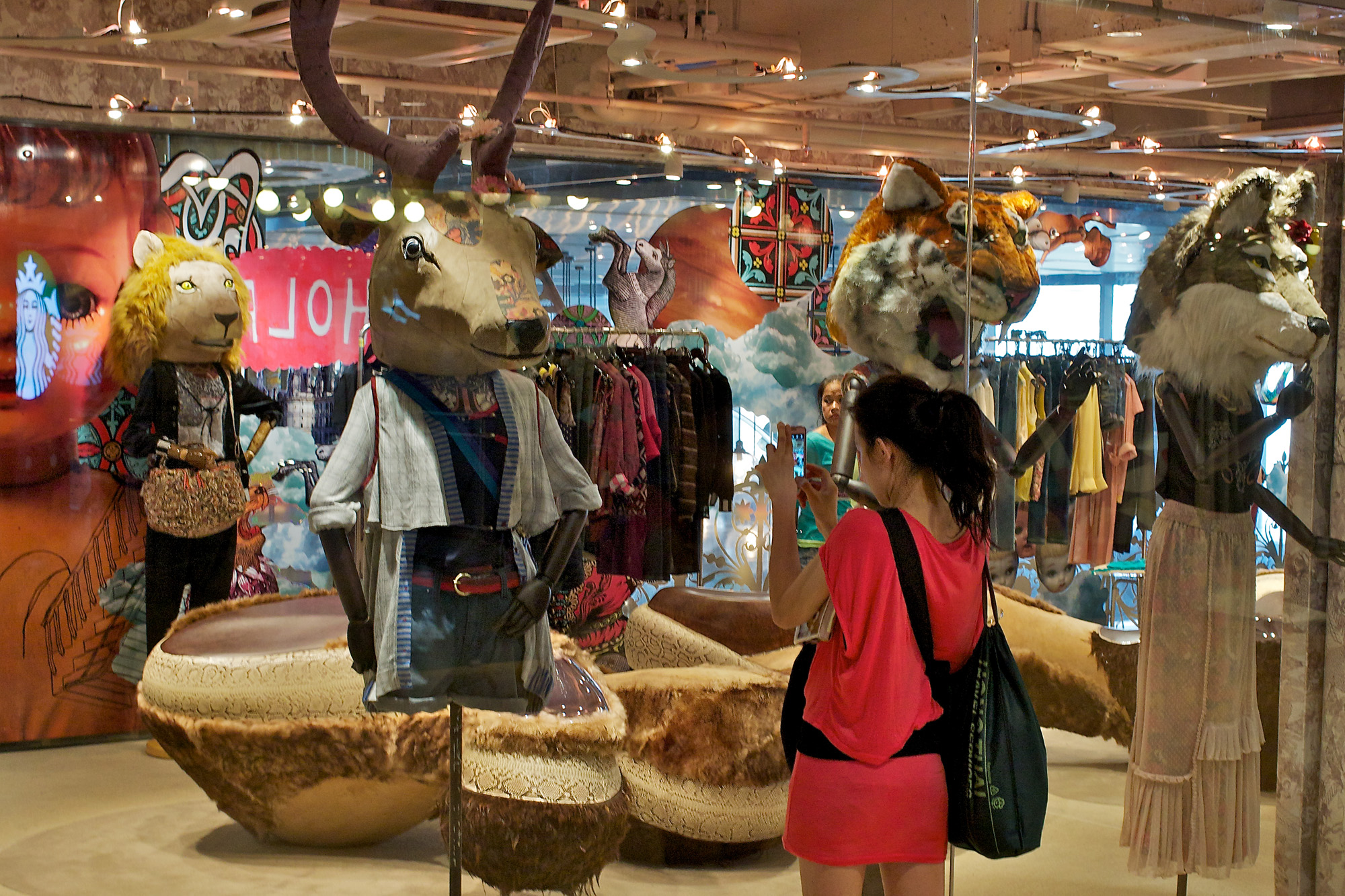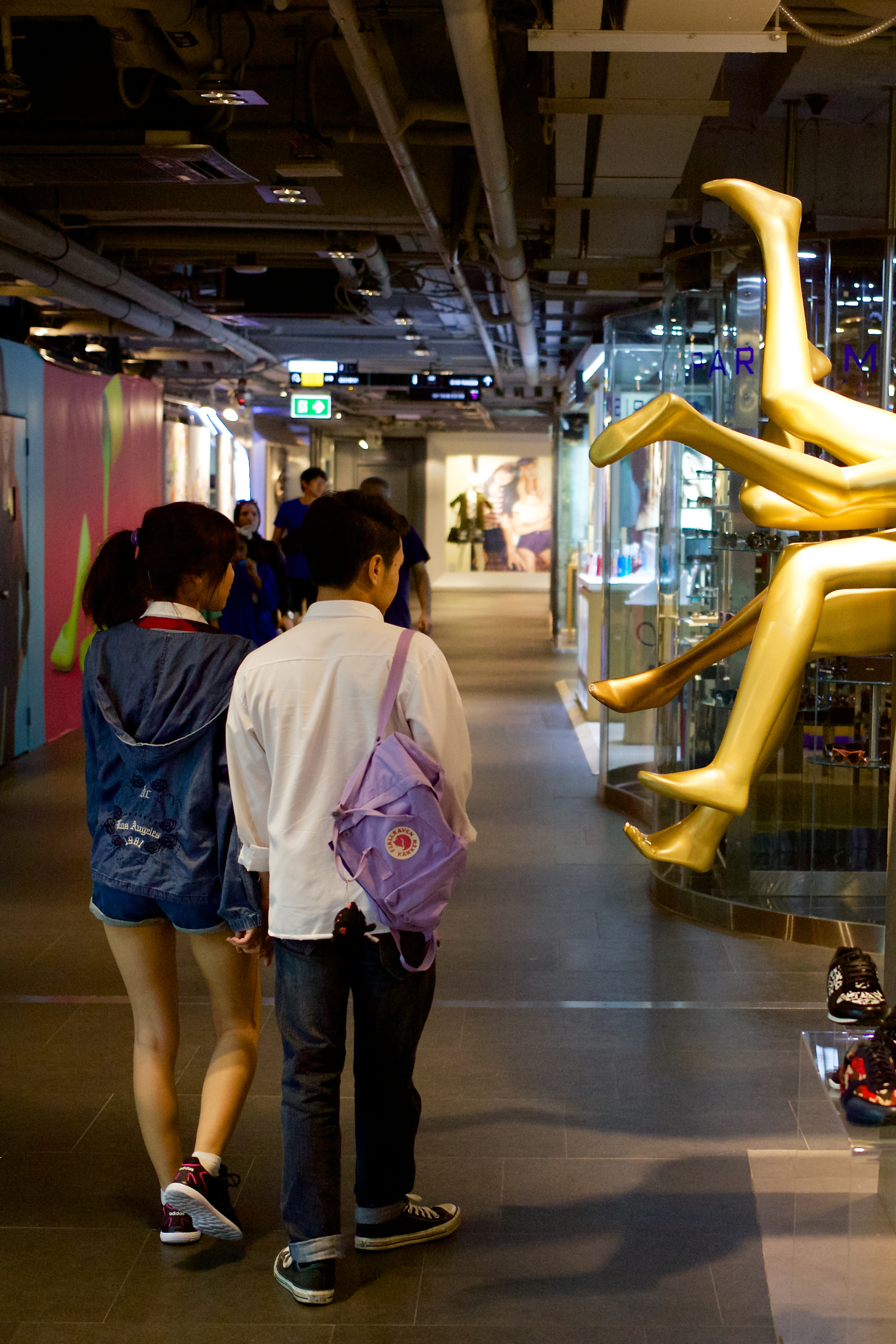For the candid photographer, shop decor is a ready-made backdrop –too good to ignore yet often out of bounds because stores prohibit photography on their premises. I can see their point of view. The interests and privacy of their customers must come first.
However, I don’t like to admit defeat. Some photographers — Michael Huniewicz springs to mind — go to North Korea and come back with hundreds of forbidden images, so I think I can grab a few shop interiors in other countries without being reprimanded.
Malls in Thailand, Singapore and Hong Kong are reasonably tolerant of photographers, providing no one gets unduly disturbed. Here, pragmatism has triumphed out of necessity, because among the best customers are tourists with expensive cameras around their necks.
The Indoor High Street
The design of the modern mall works in favour of the street photographer because the whole area is essentially a network of indoor streets. The only difference lies in the shops themselves. They blend seamlessly into the public areas with scarcely any barriers between the “street” and the interior of the shop. Sometimes it’s hard to tell whether you’re in the shop or outside it.
When there’s a physical barrier, it’s often a huge, plate glass partition separating shop from street, allowing potential customers to see the goods close-up without committing themselves to a visit. As a result, store design has become increasingly theatrical, with shops competing for attention by staging ever more eye-catching displays which many passers-by snap with their mobile phones.
As you can see from the photo below, the passer-by does not have to enter the shop to get a picture. The heads of the beasts seem to stand guard over the privacy of the customers. If photographers were to venture inside they’d find most of the animals looking in the wrong direction.
Golden Age
We live in a Golden Age of shop decor and it’s hard to imagine what will come along next. Can it get any more inventive, any more surreal? Store designers have the whole history of art from which to borrow, including everything since Dada and the Futurists. Maybe the future of art itself belongs to these creators of new shopping environments. Once they’ve exhausted the history of art they’ll have to become truly original — as I think they already are in the Far East.
For example, I can’t think of any art historical precedent for this cluster of golden legs advertising the presence of a shoe shop. It seems to have attracted the attention of the two passers-by, one of whom could use a new pair of trainers.
Moving Inside
I took my shots of the large beasts and the cluster of legs from the public space between stores. But if you want to get a better shot — and who wouldn’t? — you need to move in a bit closer. You need to be inside the store, or at least within its entrance.
My featured photo (at the top of the page) shows you the kind of image I prefer. For a start, it’s better lit than the others. The store lights were not the most intense I’ve seen, but the translucent background added wonderfully to the overall effect.
I was actually inside the store, but only just. I’d waited a minute or so for the right moment then stepped forward when the customers were in good positions. The main figure, in particular, was approaching the camera but still looking from side to side at the clothes. She seems to be the “New Arrival” referred to by the sign. Her black and white Yves St Laurent tee-shirt is nothing like the colourful clothes in the store. Surely they can’t both be in fashion?
The danger in using shop decor as a backdrop for street photography is that it can so easily become the most important part of the image. I think this is true of my picture of the woman taking a shot of the beast with her mobile phone, but it’s not true of the featured image. There are six people in the photo, none of whom is irrelevant. They are the real subject of the image. The shop is merely their environment: in wildlife terms, their natural habitat.
So you can see where this argument is headed. It’s essential for the street photographer to get off the sidewalk and go to where people are most at home — except when they’re actually at home. And where is that? At the mall.
People spend such of lot of time at the mall they cannot be said to be visiting or shopping. They’re living there, all bar sleeping over. You can have breakfast, lunch, tea, cocktails and dinner in the mall, go to the movies, and generally hang out with your friends for hours on end. Afterwards you scuttle home — and that’s when the majority of street photographers will take your image, in black and white, when you’re tired and under stress.
Wouldn’t you prefer me to take your picture in daytime at the mall?


